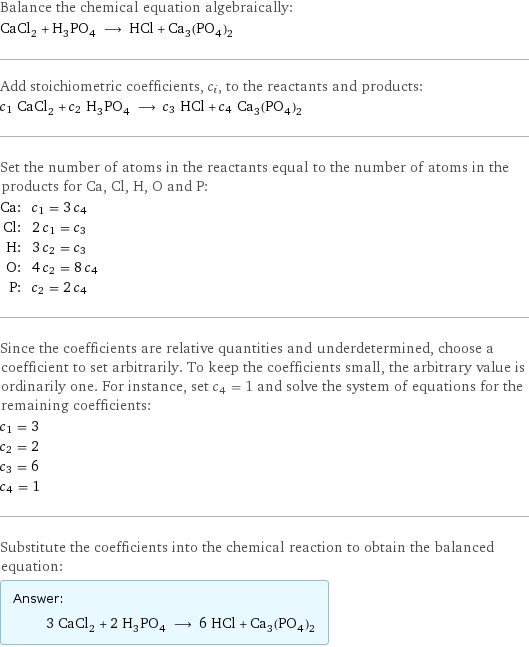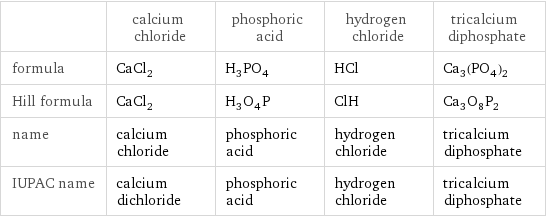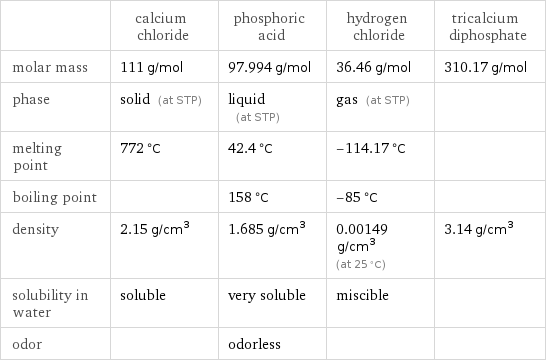Input interpretation

CaCl_2 calcium chloride + H_3PO_4 phosphoric acid ⟶ HCl hydrogen chloride + Ca_3(PO_4)_2 tricalcium diphosphate
Balanced equation

Balance the chemical equation algebraically: CaCl_2 + H_3PO_4 ⟶ HCl + Ca_3(PO_4)_2 Add stoichiometric coefficients, c_i, to the reactants and products: c_1 CaCl_2 + c_2 H_3PO_4 ⟶ c_3 HCl + c_4 Ca_3(PO_4)_2 Set the number of atoms in the reactants equal to the number of atoms in the products for Ca, Cl, H, O and P: Ca: | c_1 = 3 c_4 Cl: | 2 c_1 = c_3 H: | 3 c_2 = c_3 O: | 4 c_2 = 8 c_4 P: | c_2 = 2 c_4 Since the coefficients are relative quantities and underdetermined, choose a coefficient to set arbitrarily. To keep the coefficients small, the arbitrary value is ordinarily one. For instance, set c_4 = 1 and solve the system of equations for the remaining coefficients: c_1 = 3 c_2 = 2 c_3 = 6 c_4 = 1 Substitute the coefficients into the chemical reaction to obtain the balanced equation: Answer: | | 3 CaCl_2 + 2 H_3PO_4 ⟶ 6 HCl + Ca_3(PO_4)_2
Structures

+ ⟶ +
Names

calcium chloride + phosphoric acid ⟶ hydrogen chloride + tricalcium diphosphate
Equilibrium constant
![Construct the equilibrium constant, K, expression for: CaCl_2 + H_3PO_4 ⟶ HCl + Ca_3(PO_4)_2 Plan: • Balance the chemical equation. • Determine the stoichiometric numbers. • Assemble the activity expression for each chemical species. • Use the activity expressions to build the equilibrium constant expression. Write the balanced chemical equation: 3 CaCl_2 + 2 H_3PO_4 ⟶ 6 HCl + Ca_3(PO_4)_2 Assign stoichiometric numbers, ν_i, using the stoichiometric coefficients, c_i, from the balanced chemical equation in the following manner: ν_i = -c_i for reactants and ν_i = c_i for products: chemical species | c_i | ν_i CaCl_2 | 3 | -3 H_3PO_4 | 2 | -2 HCl | 6 | 6 Ca_3(PO_4)_2 | 1 | 1 Assemble the activity expressions accounting for the state of matter and ν_i: chemical species | c_i | ν_i | activity expression CaCl_2 | 3 | -3 | ([CaCl2])^(-3) H_3PO_4 | 2 | -2 | ([H3PO4])^(-2) HCl | 6 | 6 | ([HCl])^6 Ca_3(PO_4)_2 | 1 | 1 | [Ca3(PO4)2] The equilibrium constant symbol in the concentration basis is: K_c Mulitply the activity expressions to arrive at the K_c expression: Answer: | | K_c = ([CaCl2])^(-3) ([H3PO4])^(-2) ([HCl])^6 [Ca3(PO4)2] = (([HCl])^6 [Ca3(PO4)2])/(([CaCl2])^3 ([H3PO4])^2)](../image_source/42c20f303e1bebbd87334f0050cf9cf7.png)
Construct the equilibrium constant, K, expression for: CaCl_2 + H_3PO_4 ⟶ HCl + Ca_3(PO_4)_2 Plan: • Balance the chemical equation. • Determine the stoichiometric numbers. • Assemble the activity expression for each chemical species. • Use the activity expressions to build the equilibrium constant expression. Write the balanced chemical equation: 3 CaCl_2 + 2 H_3PO_4 ⟶ 6 HCl + Ca_3(PO_4)_2 Assign stoichiometric numbers, ν_i, using the stoichiometric coefficients, c_i, from the balanced chemical equation in the following manner: ν_i = -c_i for reactants and ν_i = c_i for products: chemical species | c_i | ν_i CaCl_2 | 3 | -3 H_3PO_4 | 2 | -2 HCl | 6 | 6 Ca_3(PO_4)_2 | 1 | 1 Assemble the activity expressions accounting for the state of matter and ν_i: chemical species | c_i | ν_i | activity expression CaCl_2 | 3 | -3 | ([CaCl2])^(-3) H_3PO_4 | 2 | -2 | ([H3PO4])^(-2) HCl | 6 | 6 | ([HCl])^6 Ca_3(PO_4)_2 | 1 | 1 | [Ca3(PO4)2] The equilibrium constant symbol in the concentration basis is: K_c Mulitply the activity expressions to arrive at the K_c expression: Answer: | | K_c = ([CaCl2])^(-3) ([H3PO4])^(-2) ([HCl])^6 [Ca3(PO4)2] = (([HCl])^6 [Ca3(PO4)2])/(([CaCl2])^3 ([H3PO4])^2)
Rate of reaction
![Construct the rate of reaction expression for: CaCl_2 + H_3PO_4 ⟶ HCl + Ca_3(PO_4)_2 Plan: • Balance the chemical equation. • Determine the stoichiometric numbers. • Assemble the rate term for each chemical species. • Write the rate of reaction expression. Write the balanced chemical equation: 3 CaCl_2 + 2 H_3PO_4 ⟶ 6 HCl + Ca_3(PO_4)_2 Assign stoichiometric numbers, ν_i, using the stoichiometric coefficients, c_i, from the balanced chemical equation in the following manner: ν_i = -c_i for reactants and ν_i = c_i for products: chemical species | c_i | ν_i CaCl_2 | 3 | -3 H_3PO_4 | 2 | -2 HCl | 6 | 6 Ca_3(PO_4)_2 | 1 | 1 The rate term for each chemical species, B_i, is 1/ν_i(Δ[B_i])/(Δt) where [B_i] is the amount concentration and t is time: chemical species | c_i | ν_i | rate term CaCl_2 | 3 | -3 | -1/3 (Δ[CaCl2])/(Δt) H_3PO_4 | 2 | -2 | -1/2 (Δ[H3PO4])/(Δt) HCl | 6 | 6 | 1/6 (Δ[HCl])/(Δt) Ca_3(PO_4)_2 | 1 | 1 | (Δ[Ca3(PO4)2])/(Δt) (for infinitesimal rate of change, replace Δ with d) Set the rate terms equal to each other to arrive at the rate expression: Answer: | | rate = -1/3 (Δ[CaCl2])/(Δt) = -1/2 (Δ[H3PO4])/(Δt) = 1/6 (Δ[HCl])/(Δt) = (Δ[Ca3(PO4)2])/(Δt) (assuming constant volume and no accumulation of intermediates or side products)](../image_source/06b3cfcceefb6ac936c5ae06b3223ef4.png)
Construct the rate of reaction expression for: CaCl_2 + H_3PO_4 ⟶ HCl + Ca_3(PO_4)_2 Plan: • Balance the chemical equation. • Determine the stoichiometric numbers. • Assemble the rate term for each chemical species. • Write the rate of reaction expression. Write the balanced chemical equation: 3 CaCl_2 + 2 H_3PO_4 ⟶ 6 HCl + Ca_3(PO_4)_2 Assign stoichiometric numbers, ν_i, using the stoichiometric coefficients, c_i, from the balanced chemical equation in the following manner: ν_i = -c_i for reactants and ν_i = c_i for products: chemical species | c_i | ν_i CaCl_2 | 3 | -3 H_3PO_4 | 2 | -2 HCl | 6 | 6 Ca_3(PO_4)_2 | 1 | 1 The rate term for each chemical species, B_i, is 1/ν_i(Δ[B_i])/(Δt) where [B_i] is the amount concentration and t is time: chemical species | c_i | ν_i | rate term CaCl_2 | 3 | -3 | -1/3 (Δ[CaCl2])/(Δt) H_3PO_4 | 2 | -2 | -1/2 (Δ[H3PO4])/(Δt) HCl | 6 | 6 | 1/6 (Δ[HCl])/(Δt) Ca_3(PO_4)_2 | 1 | 1 | (Δ[Ca3(PO4)2])/(Δt) (for infinitesimal rate of change, replace Δ with d) Set the rate terms equal to each other to arrive at the rate expression: Answer: | | rate = -1/3 (Δ[CaCl2])/(Δt) = -1/2 (Δ[H3PO4])/(Δt) = 1/6 (Δ[HCl])/(Δt) = (Δ[Ca3(PO4)2])/(Δt) (assuming constant volume and no accumulation of intermediates or side products)
Chemical names and formulas

| calcium chloride | phosphoric acid | hydrogen chloride | tricalcium diphosphate formula | CaCl_2 | H_3PO_4 | HCl | Ca_3(PO_4)_2 Hill formula | CaCl_2 | H_3O_4P | ClH | Ca_3O_8P_2 name | calcium chloride | phosphoric acid | hydrogen chloride | tricalcium diphosphate IUPAC name | calcium dichloride | phosphoric acid | hydrogen chloride | tricalcium diphosphate
Substance properties

| calcium chloride | phosphoric acid | hydrogen chloride | tricalcium diphosphate molar mass | 111 g/mol | 97.994 g/mol | 36.46 g/mol | 310.17 g/mol phase | solid (at STP) | liquid (at STP) | gas (at STP) | melting point | 772 °C | 42.4 °C | -114.17 °C | boiling point | | 158 °C | -85 °C | density | 2.15 g/cm^3 | 1.685 g/cm^3 | 0.00149 g/cm^3 (at 25 °C) | 3.14 g/cm^3 solubility in water | soluble | very soluble | miscible | odor | | odorless | |
Units
